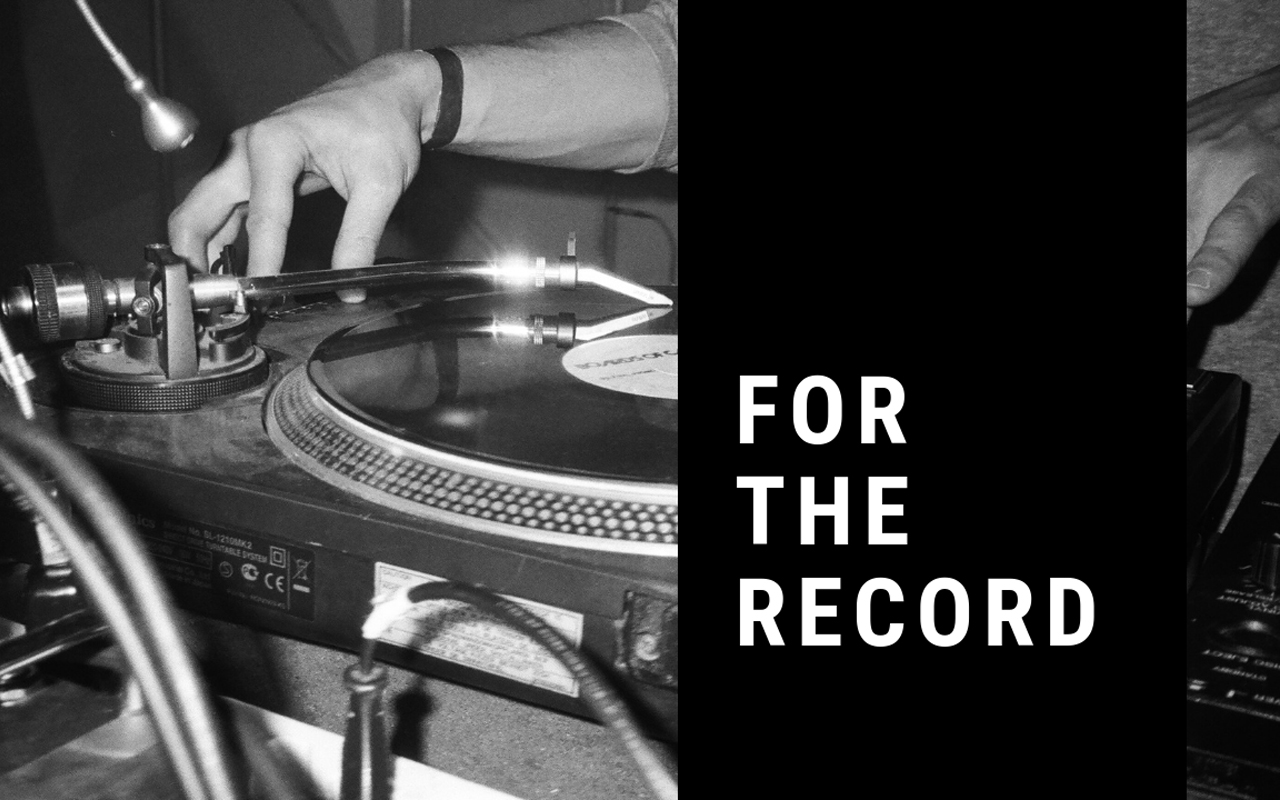
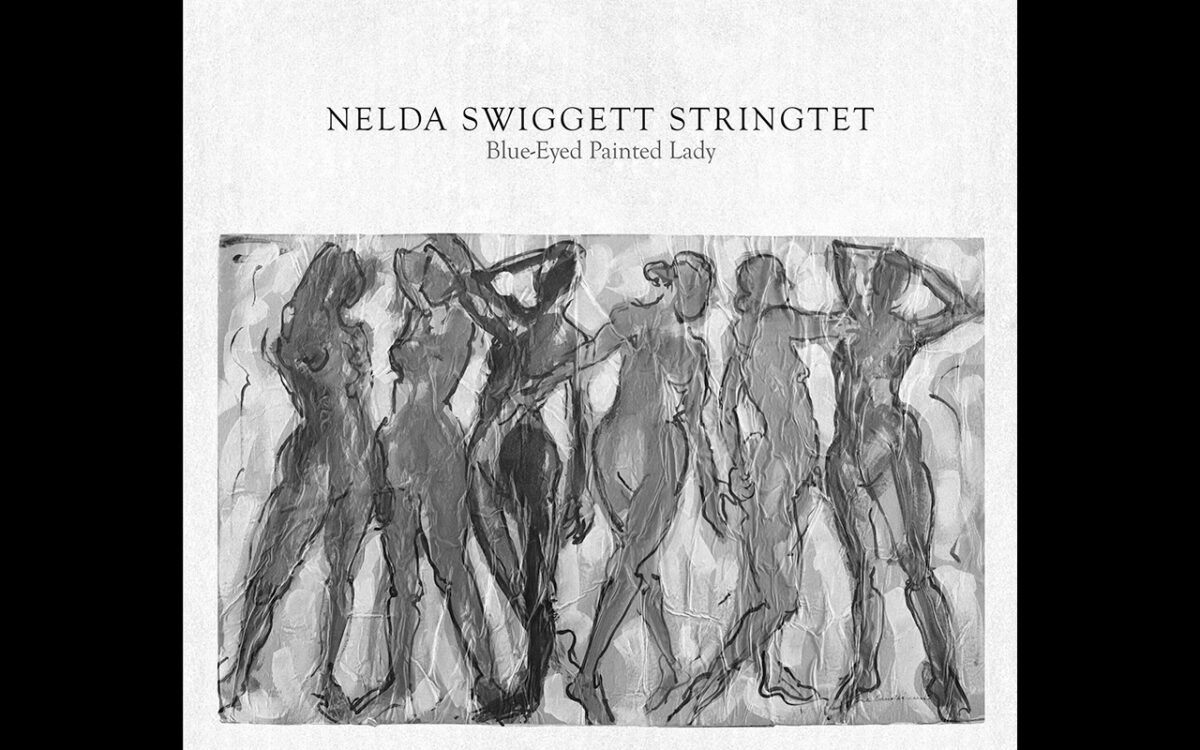
Nelda Swiggett’s Stringtet
Blue-Eyed Painted Lady
OA2 Records
Pianist and composer Nelda Swiggett’s latest offering, Blue-Eyed Painted Lady, is a 9-track disc of original compositions played skillfully by her “stringtet” – that is, her piano trio (Chris Symer, bass; Byron Vannoy, drums) augmented by violist Rachel Swerdlow and cellist Walter Gray, both of the Seattle Symphony (Gray was also a founding member of the Kronos Quartet). Though it is Swiggett’s fourth CD, it is the first recording for the stringtet. It’s a fine debut that showcases Swiggett’s voice as a composer and the abilities of the ensemble members in relative equal fashion. This is a welcome balance here, as Swiggett’s compositional voice is one of the album’s strong points.
On “Thanks to Solomon,” Swiggett’s twisting and turning of a half-step theme through various rhythmic and harmonic treatments suggests a minimalist approach. But the contrasting section is a pleasant, forget-your-worries country-blues vamp that supports a soulful piano solo. A simple bossa nova groove provides the foundation for Swiggett’s vocal line and a series of solos on the title track, whose lyrics are an ode to the pianist’s mother – an artist whose lovely painting also graces the album cover. “A Tune With a View,” with its syncopated framework and vocalized melodies, closes the album about as perfectly as possible.
– Jeff Janeczko
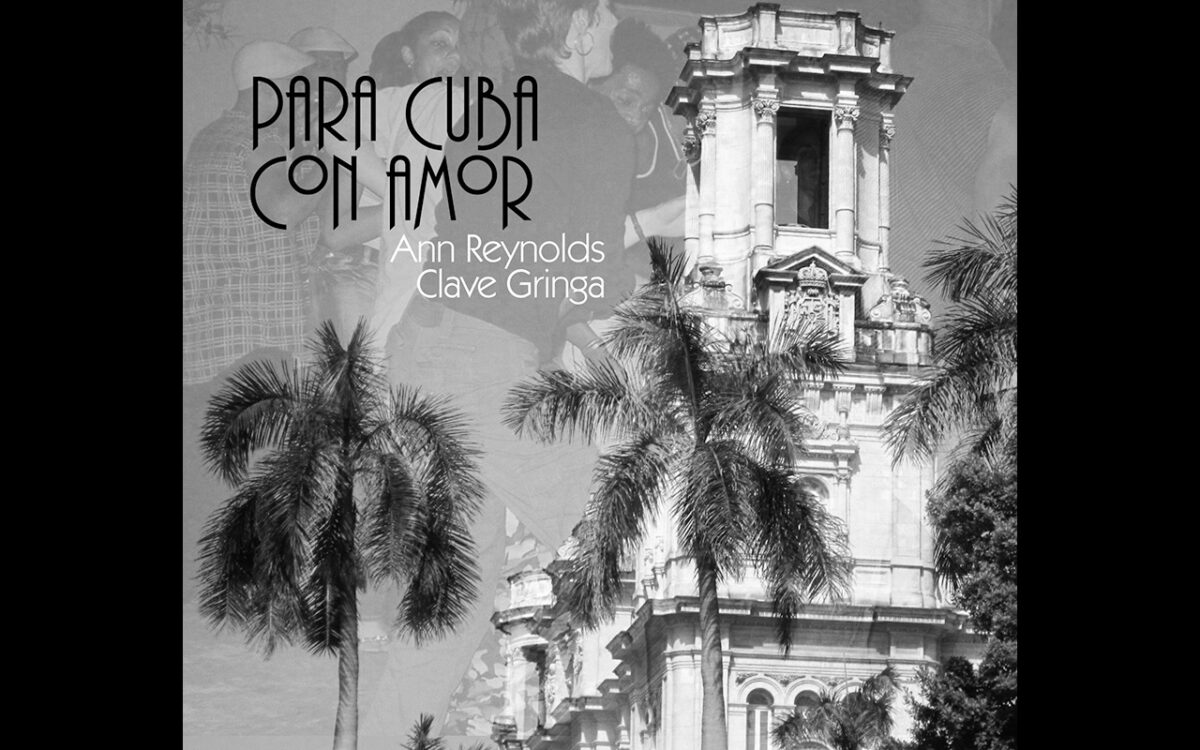
Ann Reynolds’ Clave Gringa
Para Cuba Con Amor
Self-released
Though Cuba is a relatively tiny island, it has given the world of music – especially jazz – immense gifts. With Para Cuba Con Amor, pianist Ann Reynolds and her Clave Gringa group offer Cuba, if not a gift, at least a very danceable note of thanks. Reynolds has been travelling to Cuba annually for the past fourteen years to study at the National School for the Arts and “absorb more of the music and culture.” The 11 original songs on Para Cuba Con Amor, which explore some of the myriad musical forms that have emerged from the island’s long history of intercultural contact, suggest she’s done a good job. With far more than a little güiro and a sprinkling of salsa rhythms, this collection of eleven solid compositions conveys a sense of originality without losing sight of the source of its inspiration.
The fiery son, “La Chica del Malecón,” is one of several tracks that benefit from the wonderful contributions of the La Familia Valera Miranda ensemble. This, along with “Songo Borracho” and the bolero “Working Through,” are among the more traditionally oriented cuts. Cuba’s debt to African music comes to the fore in “Sol y Luz,” which utilizes the syncopated 6/8 bell rhythm of the Santeria spirit-god Elegua as an ostinato base for an inventive arrangement. But the album really wouldn’t be an offering if Reynolds didn’t imbue it with a sense of her own spirit, which shines brightly on several tracks that treat Cuba more as a point of departure than a destination.
– JJ

Marc Smason
Mambo de Gente
Self-released
If you’re wondering what can be done about all that presently ails the world, trombonist Marc Smason has a rhetorical question for you: “Why can’t we sing and dance right thru this crap?” As the opening track of his new album (the lyrics of which are printed directly on the cover sleeve), we can only assume that making you do so is Smason’s goal with Mambo de Gente. A nine-track album that mixes covers and standards in with Smason’s originals, it’s a straight-ahead swinging album that, though not of the highest production value, is a thoroughly enjoyable listen. Smason wastes no time – getting to the point straightaway and carrying the momentum through with style and ease.
“Mambo de Gente’s” march-like dance rhythm gives way to the easy swing of “Justice Song,” which gives way even more to the slow, funky, back-alley blues of “Los Buhos.” Smason sings on several tracks, too, offering cover of Fairport Convention’s “Who Knows Where the Time Goes” and the Duke’s “Mood Indigo,” both of which are wholly his own. The same can be said of his cover of Eric Apoe’s “Sayonara.”
It’s kind of a tricky album to pin down at first, and one whose raison d’etre goes far beyond singing and dancing to forget that the world is messed up. But if you know that Smason’s an NEC and CalArts grad, and an activist who believes first and foremost in building community through music, it starts to make a little more sense. And when it starts to make a little more sense, it starts to sound like a recording that simply captured a special moment that music created.
– JJ

Brad Gibson
Poontet
Self-released
Drummer Brad Gibson named this CD after the naughty Nordic nudies adorning the walls at the Copper Gate, where this band originated. The club is gone but the risqué vibe lives on. The erotic close up female open mouth on the cover doesn’t quite have her tongue deep enough in cheek.
Featuring six compositions by Gibson, this session was recorded by Jason Gray at the Seattle Drum School, mixed by Mell Dettmer at Studio Soli, and mastered by Doug Krebs. The band recorded in the L.A.B. (Little Auditorium in the Back) of the Drum School without headphones. During post production some solos were cut and digital effects added.
One of the unusual aspects of this ensemble is the use of two keyboardists, one playing analog instruments, the other digital. Over coffee in the University District, Gibson explained, “I used two keyboards to get a bigger sound than keyboard and guitar.” Gibson likes “interplay within the moment with individuals who work well together” and is satisfied that the CD is “a complete and good representation of my compositions.”
The CD opens with “The Matriarch,” a through-composed meditation with improvisation only by the drum and keyboard accompaniment. After a written, moaning alto saxophone solo by Bryan Smith, the band breaks into silence. With nothing to fill the break, ears have a chance to breathe and gather energy before the restatement of the melody. “I Hope U Make It Dirty” uses the syllables of the title to generate the melodic rhythm. The 1960s era “K” Zildjian high hat cymbals set up the funky groove with a crisp “tick, tick, tick” beneath the cloudy pad from Mack Grout on digital keyboards and phase shifting “wee-oo-wee-oo” from Ryan Burns on analog keyboards. “Round & Round” fades in from silence to a melody playing with rhythms of threes against twos. Trumpeter Scott Morning takes a muscular solo over the open vamp, spurred by Gibson’s drum fills and driving pulse on the ride cymbal bell. The song ends with a dizzying staccato drum solo by Gibson over four repeated notes. The high hat cymbals “chick” brightly on the sentimental ballad, “Andrea.” “Twilight” features a vamp by bassist Jason Gray that turns the beat around underneath a slowly building series of long harmonies in the horns and ambient solos from the keyboards. The band sound takes me back to fond memories of 1970s collaborations between electric keyboardist Jan Hammer, electric bassist Gene Perla, and percussionist Don Alias, but with a Northwest cloud covered moodiness. “Blue Topaz” spins quick disorienting five-note arpeggios against punches by the drums and horns.
Check out Gibson’s group Synthesis, 9pm-midnight, December 10 at Vito’s.
– Steve Griggs
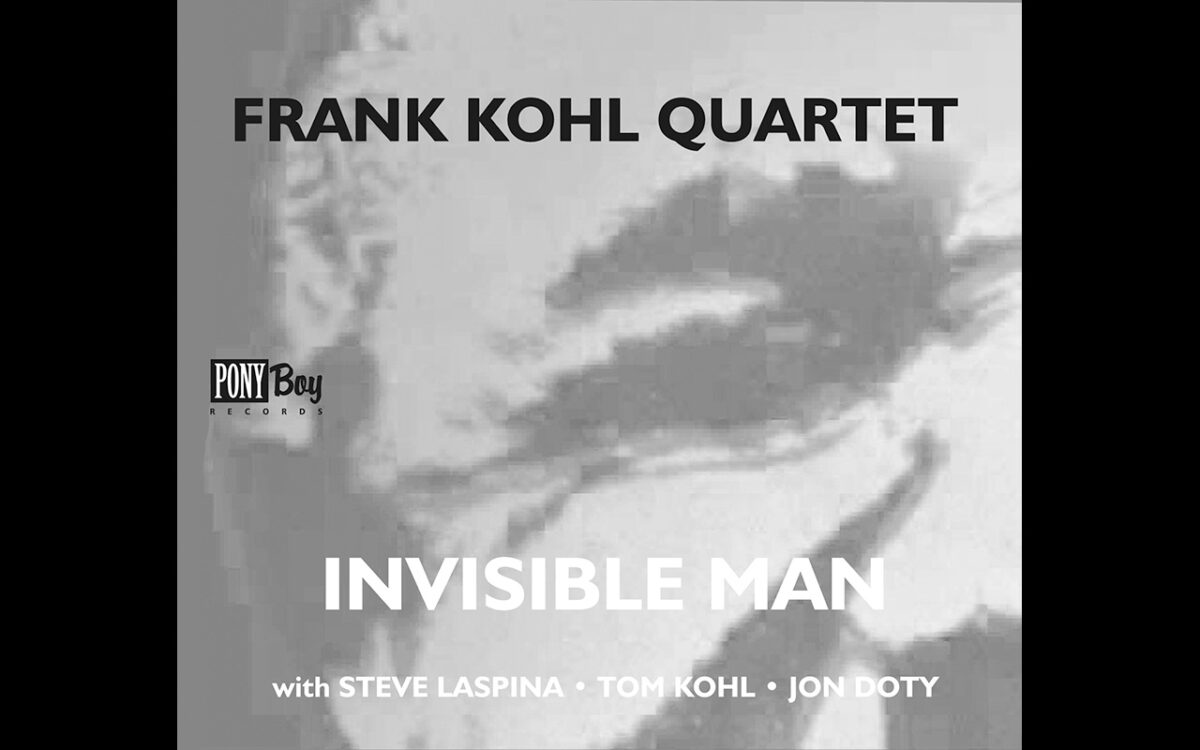
Frank Kohl
Invisible Man
Pony Boy Records
Guitarist Frank Kohl may wrestle with his own inner demons of distraction and insecurity, but you can’t hear that on his third recording, Invisible Man. His soaring solos and swinging tunes unveil a spirit tuned in to the moment and where the notes may lead.
Originally from New York State, Kohl learned music in his high school jazz band, got inspired at clubs in New York City, studied at Berklee in Boston, and returned to New York City as a professional, recording his first CD, Reform, with bassist Michael Moore in 1981. Kohl migrated to the Bay Area in 1983 and joined a band called Warmth led by vibraphonist Don McCaslin. Then he met his Seattle-born wife and they moved to the Pacific Northwest. She teaches yoga and keeps Kohl’s negativity cool. But Kohl walked away from music ten years ago.
Kohl’s creative flame was rekindled hearing Jim Hall at Jazz Alley. Bassist Steve LaSpina really impressed him. LaSpina is a “super strong and tuned in listener and player,” Kohl told me over the phone. “He gives so much of himself. He comes from that school of being more involved with the music, like Eddie Gomez. I get something back from him that inspires me.”
The inspiration led to this recording of five Kohl originals and three standards at Tedesco Recording Studio in Paramus, NJ, by Kohl and LaSpina, Frank’s brother Tom on piano, and drummer Jon Doty. Greg Williamson at Pony Boy mixed the session and Ross Nyberg mastered the recording in his Issaquah studio.
While Kohl clearly mastered technique, his guitar solos sing true with room for breath and emotion. The strong swing, bass pedal, and catchy melody of the title track echo compositions by Oliver Nelson and Bobby Timmons. The two-beat folky “In Your Arms” harkens from the ilk of guitarist Pat Metheny, who was on the Berklee scene while Kohl attended classes there. “Born Again” swings in a minor key with a brief tag between the end of the bridge and the recapitulation of the opening melodic phrase. “Falling Sky” sambas through a unison figure and melancholy melody. “Round About” is a swinging blues with the last phrase sliding smoothly down chromatic cadences. Standards “My Funny Valentine,” “My One and Only Love,” and “Alone Together” round out this enjoyable recording.
Music that emphasizes feeling can be difficult to capture in the recording studio. For Invisible Man, Kohl said he “did have a lucky day with magical moments in it.”
Come hear some magic at the CD release performance, 9pm, December 27 at Egan’s Ballard Jam House.
– SG
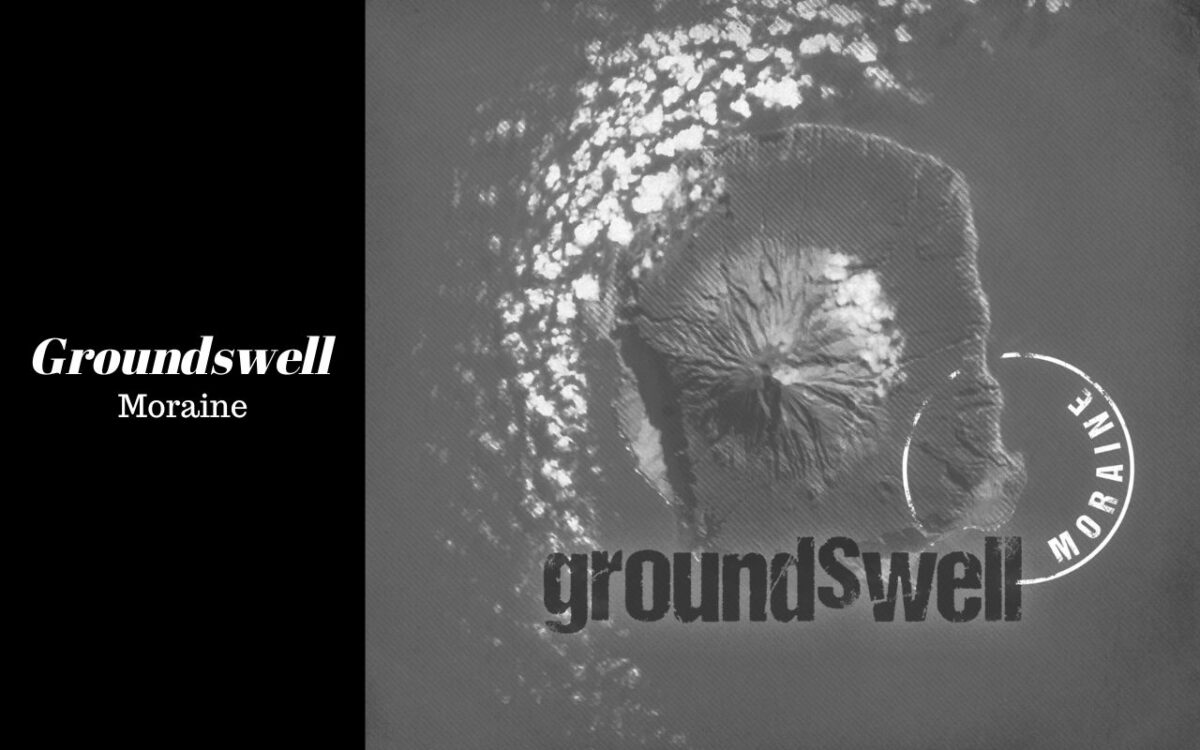
Moraine
Groundswell
MoonJune Records
The geologic theme of Moraine extends to one of the major genres influencing its formation: progressive rock. The band’s leader, Dennis Rea, cites 1970s bands King Crimson, Soft Machine, and Gentle Giant as the magma from which Moraine erupted.
Eight years ago, guitarist Rea started down the path to this recording as a duo with cello. More strings and percussion joined the journey. Eventually Rea collected the current lineup of Alicia DeJoie (violin), James DeJoie (reeds, flute), Kevin Millard (stick bass), and Tom Zgonc (drums) and deposited them at Soundhouse recording studio in Ballard. Engineer Steve Fisk (Nirvana, Soundgarden) piloted the vintage Trident 80B console. Rea set up the studio’s guitar amplifier in the bathroom, the same amp that Kurt Cobain used on his first record.
While the mix may sound just fine on computer speakers, the sonic depth, and detailed placement of enriched sounds deserve closer listening on headphones at high volume. Rea wanted to make this recording an enveloping experience like their live sound. Mission accomplished. The electric violin sounds sometime take on the character of an overblown blues harmonica. The signal processed baritone saxophone thrusts like a second distorted guitarist. The odd time signatures are deep in the pocket. The audio signals are blazing hot. The decays of each song’s last sound are handled with finesse.
“Mustardseed” by Daniel Barry grows from undistorted power chords on bass, though a slow anthem of rising notes in the saxophone and violin, pushed by steady drumming, blooming into a chalkboard scratching guitar freakout. “Gnashville” by Rea turns Tennessee up to eleven. Remember the fiddle solo on “The Devil Went Down to Georgia” by Charlie Daniels? Now crank it up and distort the hell out of it. You will only be scratching the surface of where this track goes. “In That Distant Place” by Jon Davis is awash in reverb over a mellow seven and a half beat groove. “Synecdoche” by James DeJoie starts as a five and a half beat figure and evolves into a four on the floor jam. “The Earth is an Atom” by Alicia DeJoie glides along mostly in six beats and pans the baritone sax from left to right. “Spiritual Gatecrasher” pulls out the distortion pedals with a ten beat vamp under a flute melody. After a quick interlude, a flute and violin take modal solos over the closest the drums come to a jazz ride cymbal pattern. “The Okanogan Lobe” closes the playlist with a lead guitar head banger. Fist pumps and moshing switch briefly to an off balance genteel waltz, then back to hammering grooves for the solos. All bow to the great spirits of feedback and distortion!
Moraine synthesizes progressive rock, grunge, and jazz with a uniquely Seattle slant.
Check out the CD release concert, 8:30pm, December 14 at Columbia City Theater (21+).
– SG

Nate Omdal & Spekulation
Enemy Within
(The Original Soundtrack)
United Artists Initiative
Bassist Nate Omdal likes the “Italian cooking” style of music creation – put the right ingredients (musicians) together in the pot (studio) and the results can be delicious (spectacular sounding). In the case of the soundtrack for the short narrative dance film Enemy Within, it was Josh Rawlings on piano, Begin Scarseth on violin, Maria Scherer Wilson on cello, and Nate Omdal on double bass in the PONCHO Concert Hall at Cornish College of the Arts being sampled by “bitter barista” rapper/producer Matt Watson a.k.a. Spekulation.
Omdal composed and rearranged stripped down dramatic harmonic cadences from Mozart’s opera “Don Giovanni” and Aaron Copeland’s orchestral suite “Appalachian Spring.” Clean performances of these sketches formed the building blocks for mixing and morphing by Omdal and Watson to represent the film’s narrative of a dancer representing insecurity as she stalks and challenges three other dancers struggling with beauty, self image and confidence. The film spans ballet, modern, and dubstep dancing and the soundtrack became the basis for the film’s choreography.
The visuals for “Enemy Within” are powerfully beautiful, so please hear the music in the context of the film. The movements, bodies, lighting, staging, editing and sound effects are works of art in themselves. The soundtrack consists of five acts and music for the end credits.
It’s amazing how the music focuses and frames the story for the dance and film. Act one blends a minor descending chord progression in the piano strings with the buzzy wah from the dubstep DJ palette. Act two features delicate rippling piano solos by Josh Rawlings over Omdals plucked bass and string pad. Act three starts with a suspended descending chord progression joined with dubstep electronics and drums, cutting back and forth between the acoustic and electronic sounds, at times layering them together. Act four builds on the established motifs and moods, but now with an ascending progression. Act five begins with a chiming celesta and detuned piano.
– SG
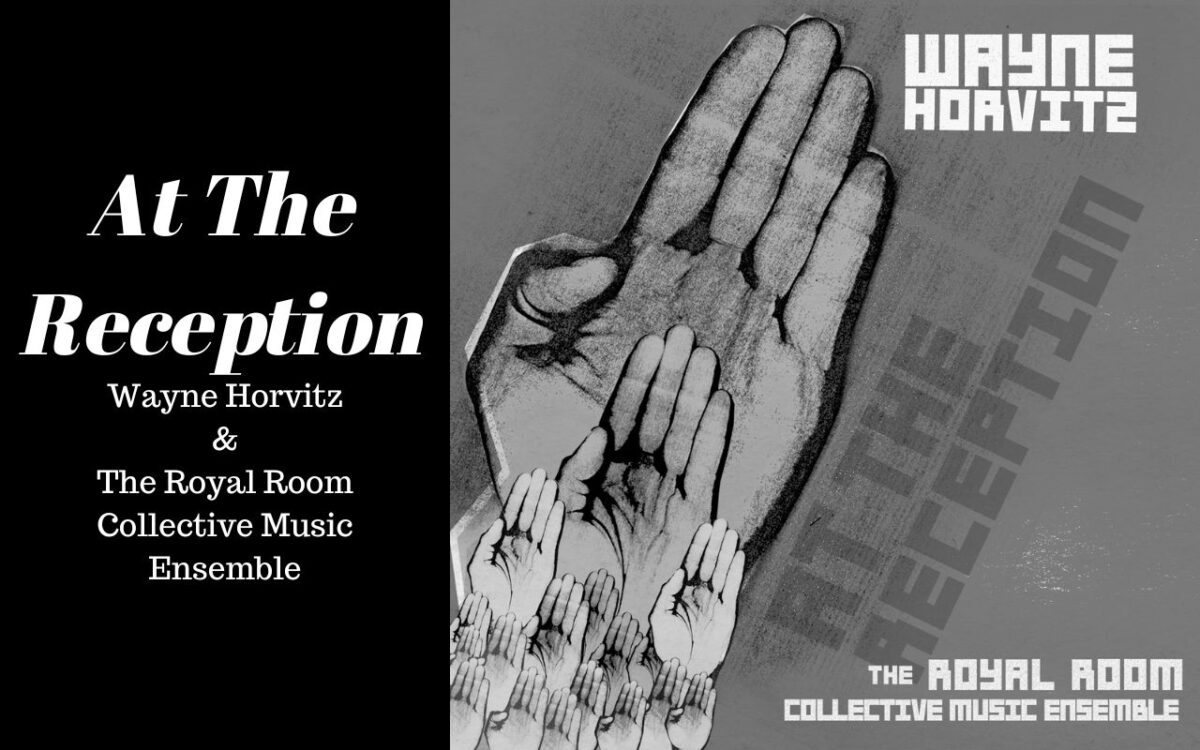
Royal Room Collective
Music Ensemble
At the Reception
Songlines
The first day of recording for the Royal Room Collective Music Ensemble at London Bridge Studios went so well, saxophonist Skerik asked, “Why are we coming back tomorrow?” Not that the day was grueling. In fact it was very relaxed. Everyone was in a good mood. Everyone was in the same room and no one wore headphones, just like the extremely casual every other Monday night gigs at the Royal Room over the last two years. There was food and beer. The band made three or four takes of each song in the same order that they appear on the CD so there was not much need for editing. Only one tune was spliced from multiple takes. Andy Meyer manned the board at London Bridge, Brian Montgomery mixed the session, and Graemme Brown mastered the recording.
The result is breathtaking – flawless, flowful, continuously intriguing, swinging, surprising, and an honest representation of the how the ensemble sounds live. Horvitz admits to maybe not taking the band right to the edge of the cliff in the studio like he does at the group’s home in Columbia City. But he did use the “conduction” technique of his mentor Butch Morris – improvising the performance of each piece through cues instead of reading a song from the upper left of the first page to the lower right of the last.
“A Walk in the Rain” evokes film noir, but slightly more playful than the cynical movie genre. “Forgiveness” shows off Horvitz’s gorgeous orchestration, tenderly and meticulously performed and improvised upon by the winds. The tonal colors are so rich, even the tinniest ear will experience synesthesia. “Barber Shop” bounces like a parade of marching clowns with saxophone solos by a swooping and diving Kate Olson on soprano and a squawking Skerik on tenor. “Ironbound” begins with weaving counterpoint between Ivan Arteaga’s alto saxophone and Beth Fleenor’s clarinet yielding to a drunken waltz with an energetic Eric Eagle drum solo over a unison melody by the winds, through a few sparsely decorated melodies, then a return of the unison a second time with a clarinet solo. “Prepaid Funeral” comes alive with Al Keith bopping over a Morse code vamp by the piano and drums. Ivan Arteaga inserts improvised comments inside the melody then trombonist Willem de Koch launches a golden toned flight over a group improvisation. The rhythm section shrinks to a whisper for an intimate exploration by tenor saxophonist Skerik. Ryan Burns begins “First Light” with pointillist notes over a shifting fog of winds. The fog thickens with freely improvising reeds and rhythm shadowed by brass clouds. Again Horvitz highlights his colorful orchestration and the ensemble displays its masterful unity of sound. “Sweeter Than the Day” is arranged as a rich wind ensemble hymn to again feature the savory trombone tone of Williem de Koch and syrupy saxophone testifying of Skerik. The title track, “At the Reception,” is a swinging affair with trumpeter Steve O’Brien boisterously greeting visitors. Kate Olson pirouettes through the crowd on soprano saxophone with Beth Fleenor deftly balancing drinks as she jostles through her clarinet solo. “Redux #4 (Sweeter Than the Day)” closes the CD with a succinct low down mournful interpretation this time through.
– SG
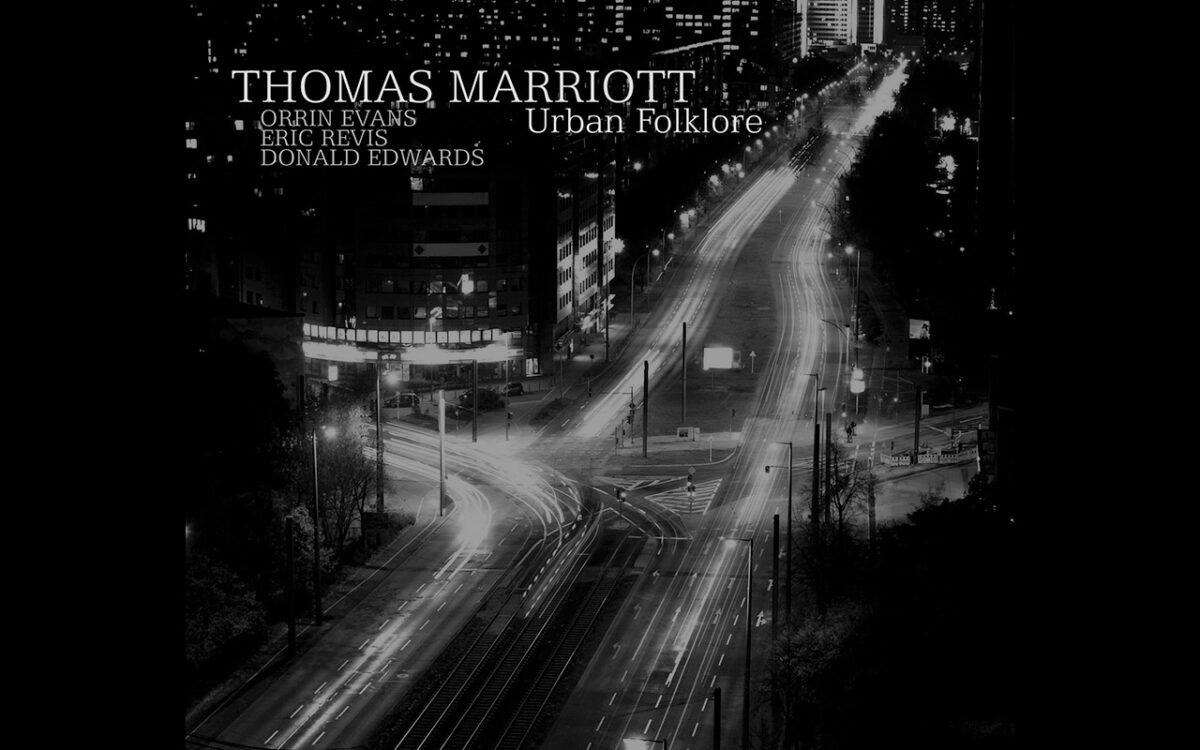
Thomas Marriott
Urban Folklore
Origin Records
“The job of a musician is to illustrate the human condition.” On his latest album, ace trumpeter Thomas Marriott lays out his musical ethos. Marriott conceived the nine original tunes on Urban Folklore as musical story-telling, evocations of shared human experience.
While knowing the underpinnings behind Marriott’s musical concepts may deepen the experience, it’s not required to revel in the music itself – vigorous post-bop, executed with nuance, anchored by Marriott’s smeary, lush tone and backed by a hard-driving East Coast threesome of Orrin Evans on piano, Donald Edwards on drums and the authoritatively woody presence of bassist Eric Revis. Marriott’s bandmates play with the conviction and rapport of a working trio, and the vibe is that of a cohesive quartet, rather than the sidemen/leader dynamic found on many jazz sessions.
The music is strong throughout, but I’m partial to the second half of the disc: The cinematic, funky mood of “Locked Up,” the loosely angular playfulness invoking Monk and Dolphy on “Living on the Minimum,” and the bossa-tinged R&B groover “Washington Generals,” showcasing expansive and exploratory work from Marriott and Evans, as well as some welcome solo space for Edwards.
While perhaps not as brazenly exploratory as some of his superb past work (check out Crazy: The Music of Willie Nelson), Urban Folklore is not only a burning modern jazz album but another solid step towards consolidating Marriott’s status as one of Seattle’s most reliably versatile and creative musicians.
– Andrew Luthringer
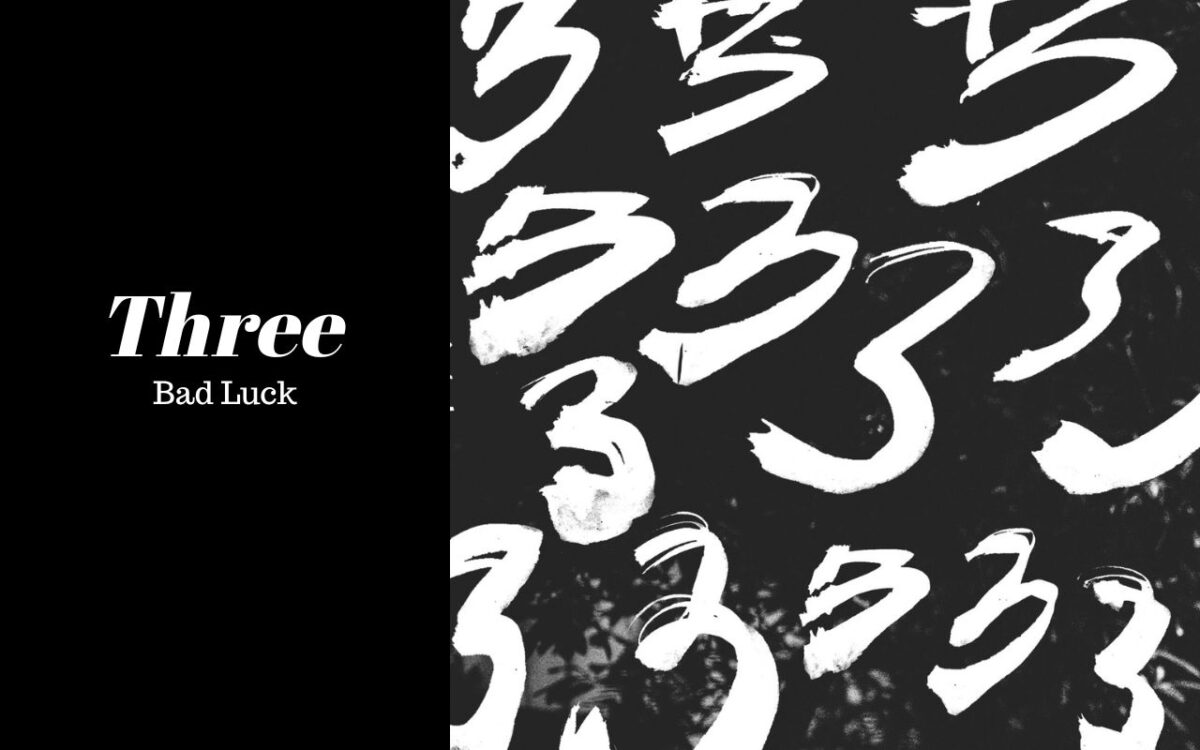
Bad Luck
Three
Table & Chairs
The singular duo of drummer Chris Icasiano and tenor saxophonist Neil Welch, who could arguably be described as one of Table & Chairs’ marquee acts, intensify and extend their alliance on the superb Three. Sounding literally like the work of one brain and two instruments, their obvious deep connection as improvisers and uniquely interconnected compositional instincts are augmented by Welch’s judicious but superbly effective use of electronics. The agile duo’s sturdily constructed pieces are immaculately executed – often skeletally minimal yet perfectly proportioned.
The album’s highlights are many and varied. The title track’s intervallic acrobatics yield an ambiguous blurring of the lines between avant-freedom and tight structure; the power-drone of “Ideal City” provides a satisfying rattle to the body cavities; and “Power Ballad” truly lives up to its name, interspersing punchy blasts of sound with ominously beautiful ambient ballad sections.
The sole cover is Roscoe Mitchell’s “Nonaah,” which closes out the album, and is an apt choice to make literal part of the lineage that Bad Luck is updating, paying tribute to a kindred spirit yet operating on their own terms. With Mitchell, they share some sonic common ground but also something more important: A relentless and uncompromising pursuit of their own artistic vision.
– AL

Chemical Clock
Bad Habitat
Table & Chairs
In describing Chemical Clock’s Bad Habitat, there’s a temptation to fall back on an exhaustive (and exhausting) listing of hyphenated genre influences (post-prog-soundtrack-fusion-chamber-pop-this-and-that), but this doesn’t really do the music justice. Suffice to say that the myriad invocations in the band’s music make for a referential richness that is difficult to describe. The band traffics in rhythmic precision, fiercely executed riffage and a studious aversion to 4/4 time, but are also fully at ease with a sweetly lyrical melody (“Spring Forward”), a pumping disco groove (“Roy”), dark free jazz textures (“Squid”) or a catchy synth hook (pretty much every track).
Cameron Sharif’s intricate compositions and multifarious keyboard textures pull the music towards outer space, as Ray Larsen’s versatile and velvety trumpet (even when mutated by electronics) helps keep the band sound rooted in earthly pleasures, while the bass and drums tandem of Mark Hunter and Evan Woodle lock it all down like a rhythm section is supposed to, at least a rhythm section on whatever planet Chemical Clock has emigrated from. Deploying prodigious chops, they produce absurdly varied textures for a quartet, yet they make the balancing act seem easy and natural, all the while tempering the seriousness of their execution with an evident sense of humor.
Unlike some other polymath forebears where the lines between parody, irony and sincerity were more clearly defined (Frank Zappa comes to mind), Chemical Clock seem to embody a more fluid, less self-conscious sense of musical identity. While some similarly inclined bands sound merely like a sum of their impressive record collections, Bad Habitat just sounds like, well, Chemical Clock. A stellar effort.
– AL
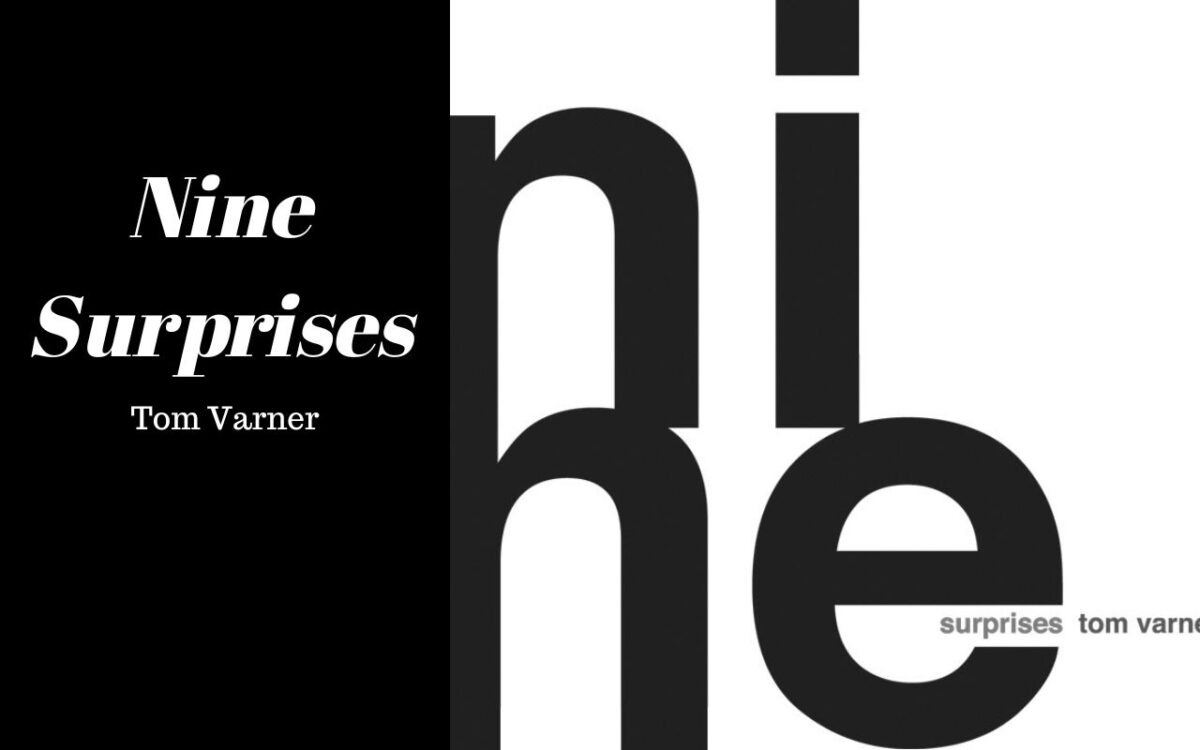
Tom Varner
Nine Surprises
Tom Varner Music
Hopefully, we’re many years past the stage where Tom Varner has to explain the “jazz French horn,” and instead have arrived at a point where he can simply be considered an amazingly sensitive, versatile and skilled musician, who combines the execution of classical training with the free-ranging experimentalism and vocabulary of jazz. On Varner’s latest self-released album Nine Surprises, his considerable skills as a composer and arranger also share the spotlight.
Featuring a stellar 9-piece ensemble of Seattle jazz luminaries, Nine Suprises is structured as a suite, interspersed with short improvisational interludes from some of the ensemble. The writing is richly textured, with beautifully ambiguous sonorities and harmonies recalling the inescapable influence of Gil Evans, with a scent of Third Stream 20th-century modernism, and a hint of Henry Threadgill in his more relaxed moments.
“Main Theme” lays out a wandering, somewhat languorous mood for the suite, and though a number of the sections mine a similar ambience, there is enough variety to keep listeners energized, with plenty of solo space for the top-notch band as they navigate through the wide intervallic leaps and tart chord clusters. On the driving closer “Mele,” the soloists and structure hint at sunnier jazz climes, only to be pulled back to Varner’s darker vision as the horns get the last laugh with interjections of tight and thorny chromatic harmonies. It’s a great way to go out.
– AL